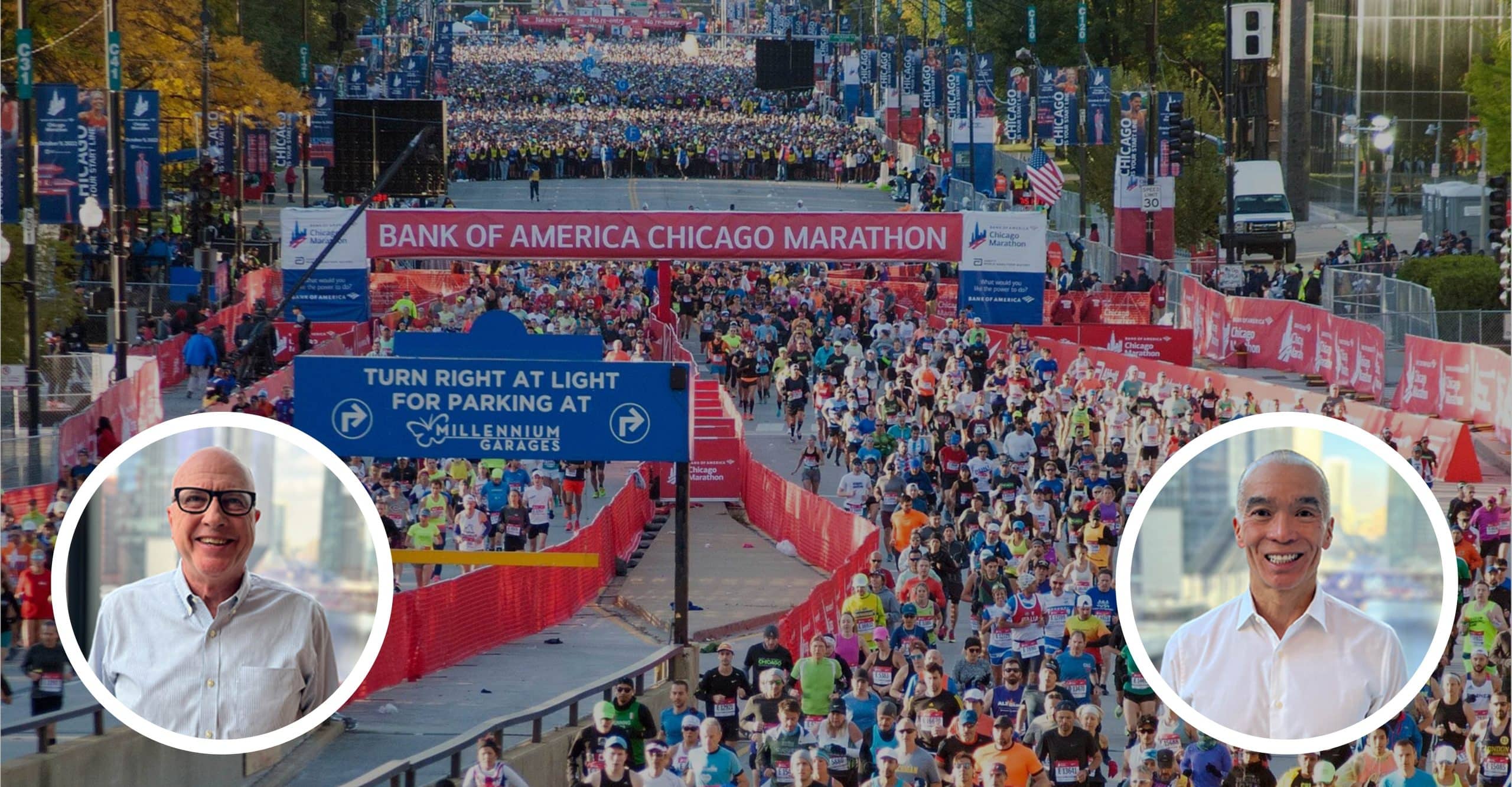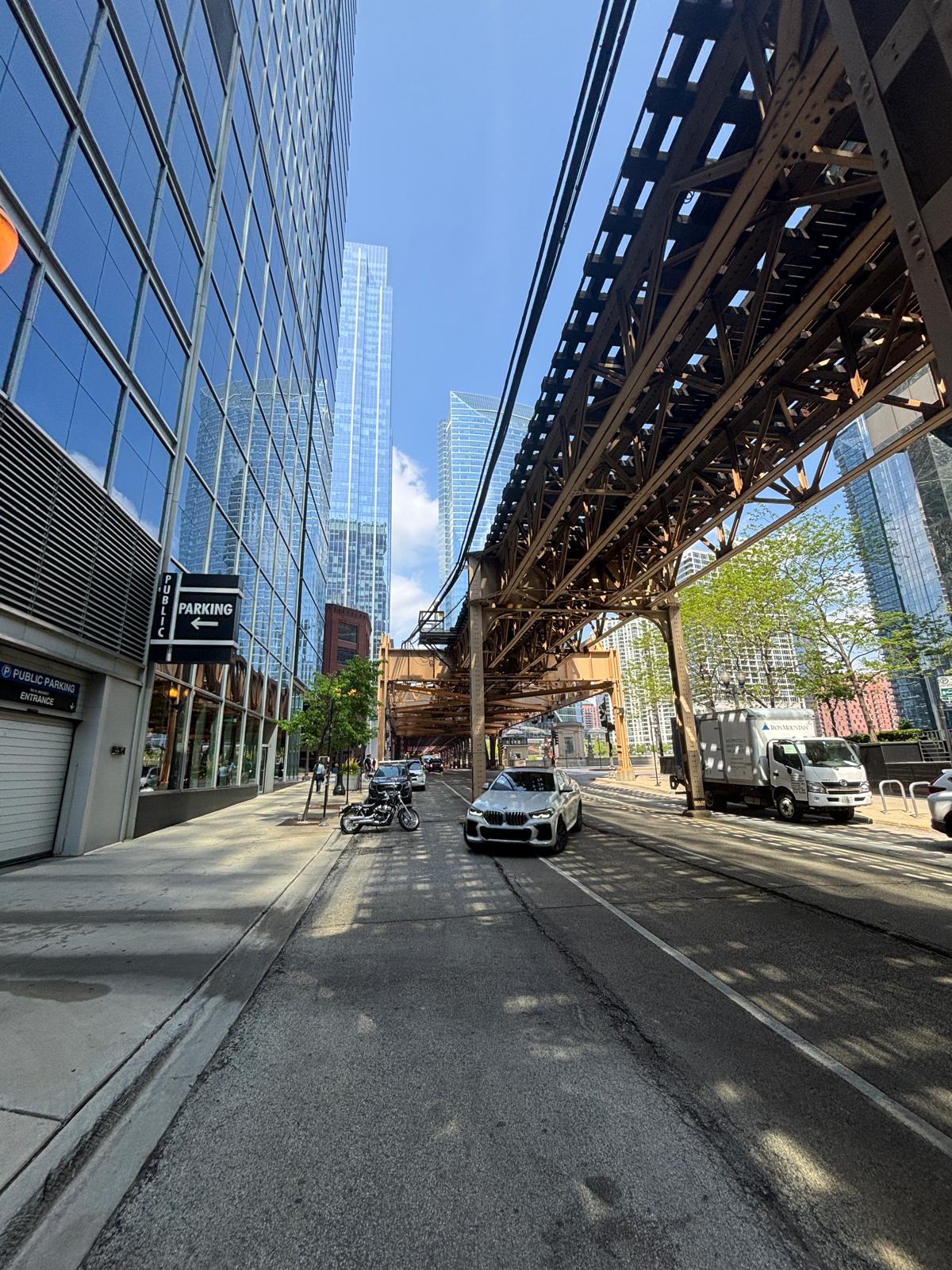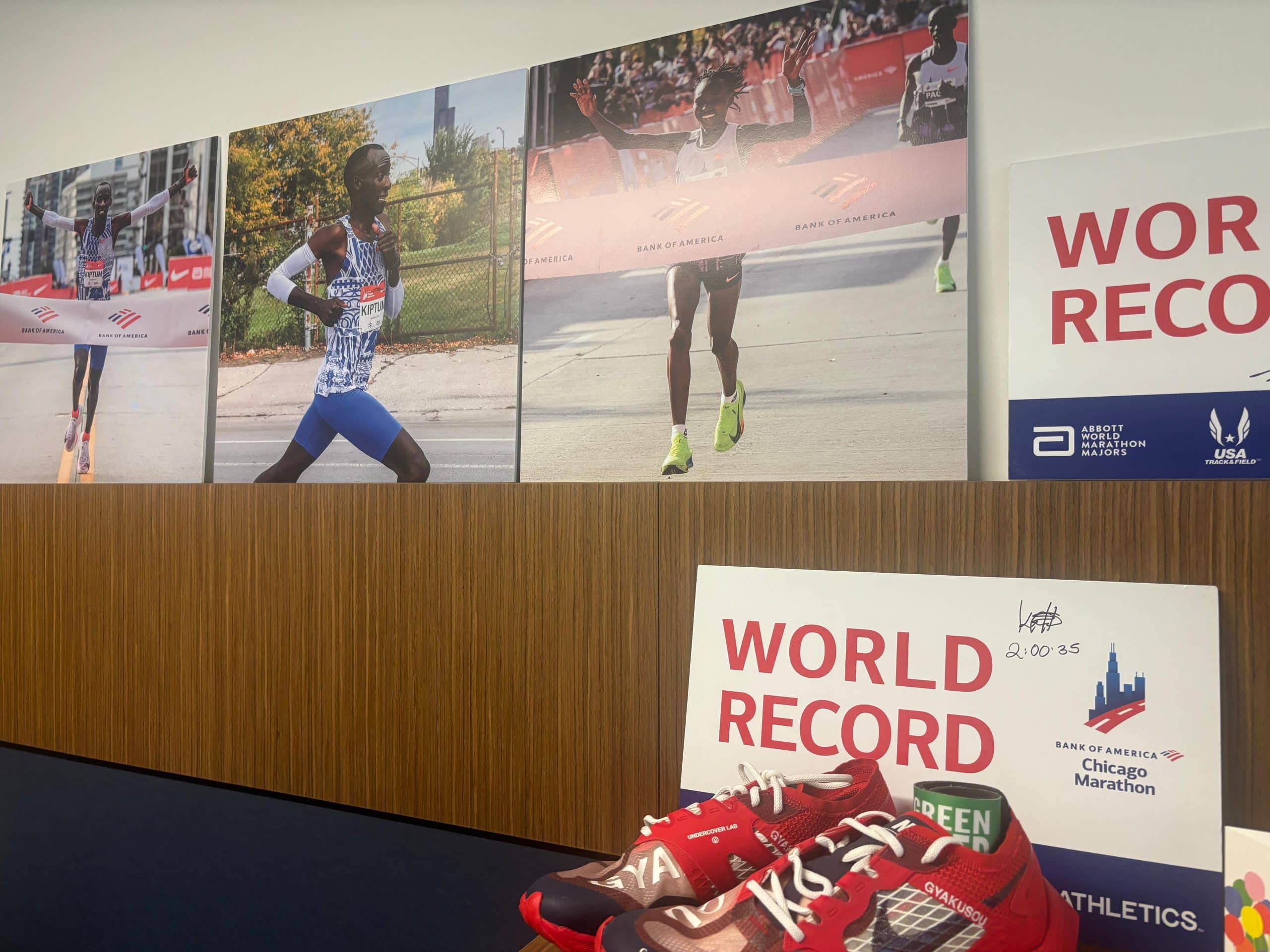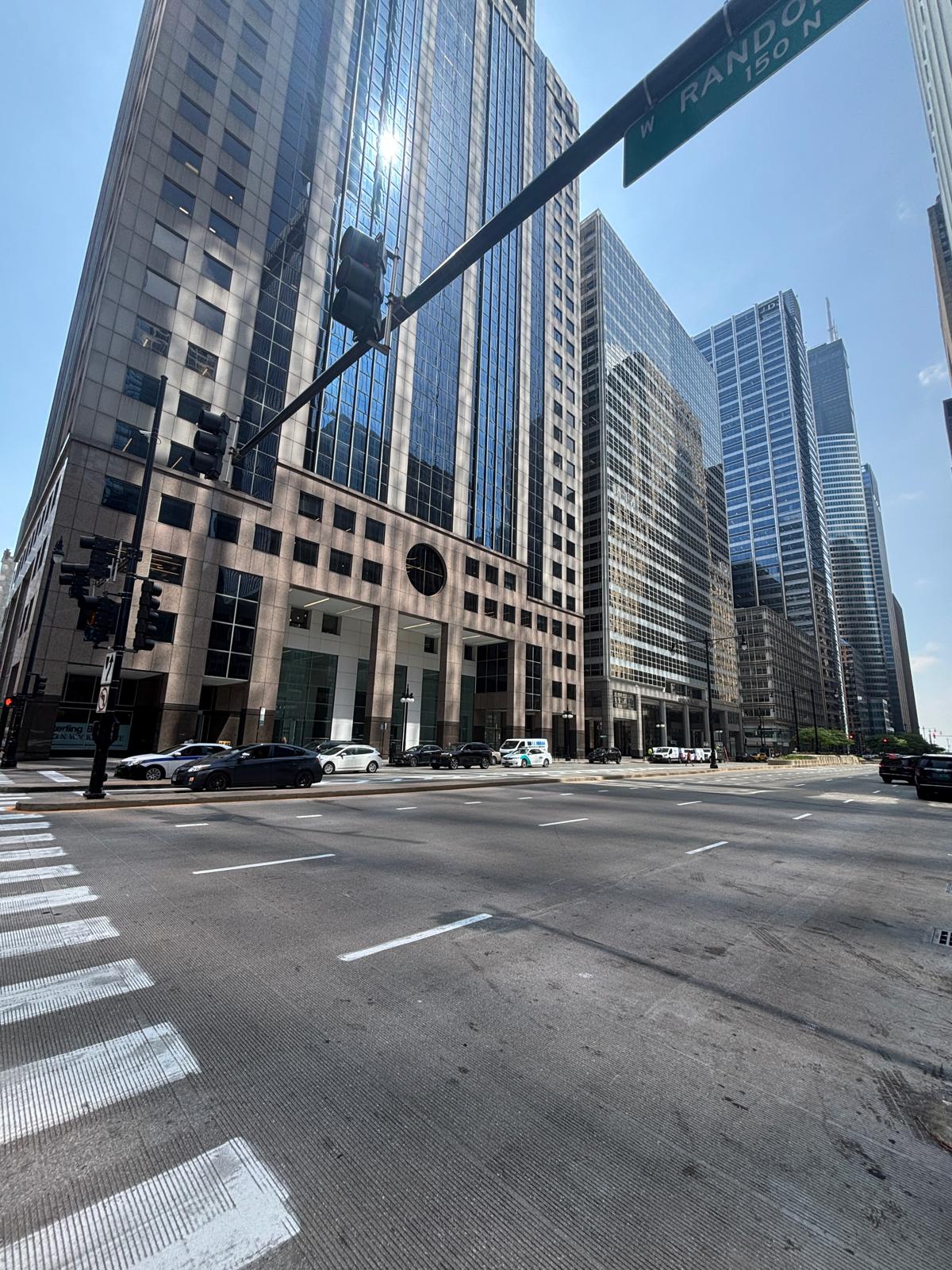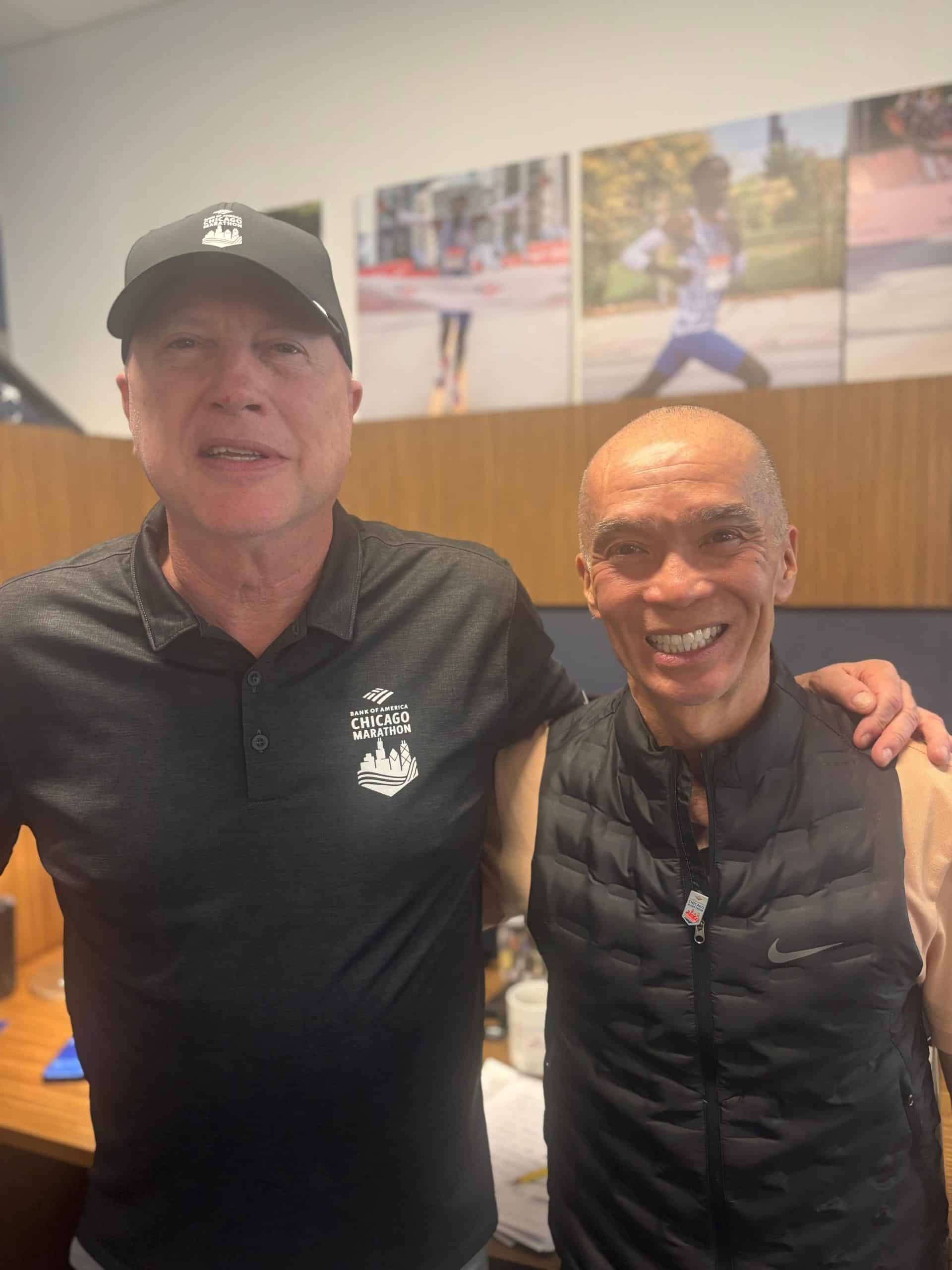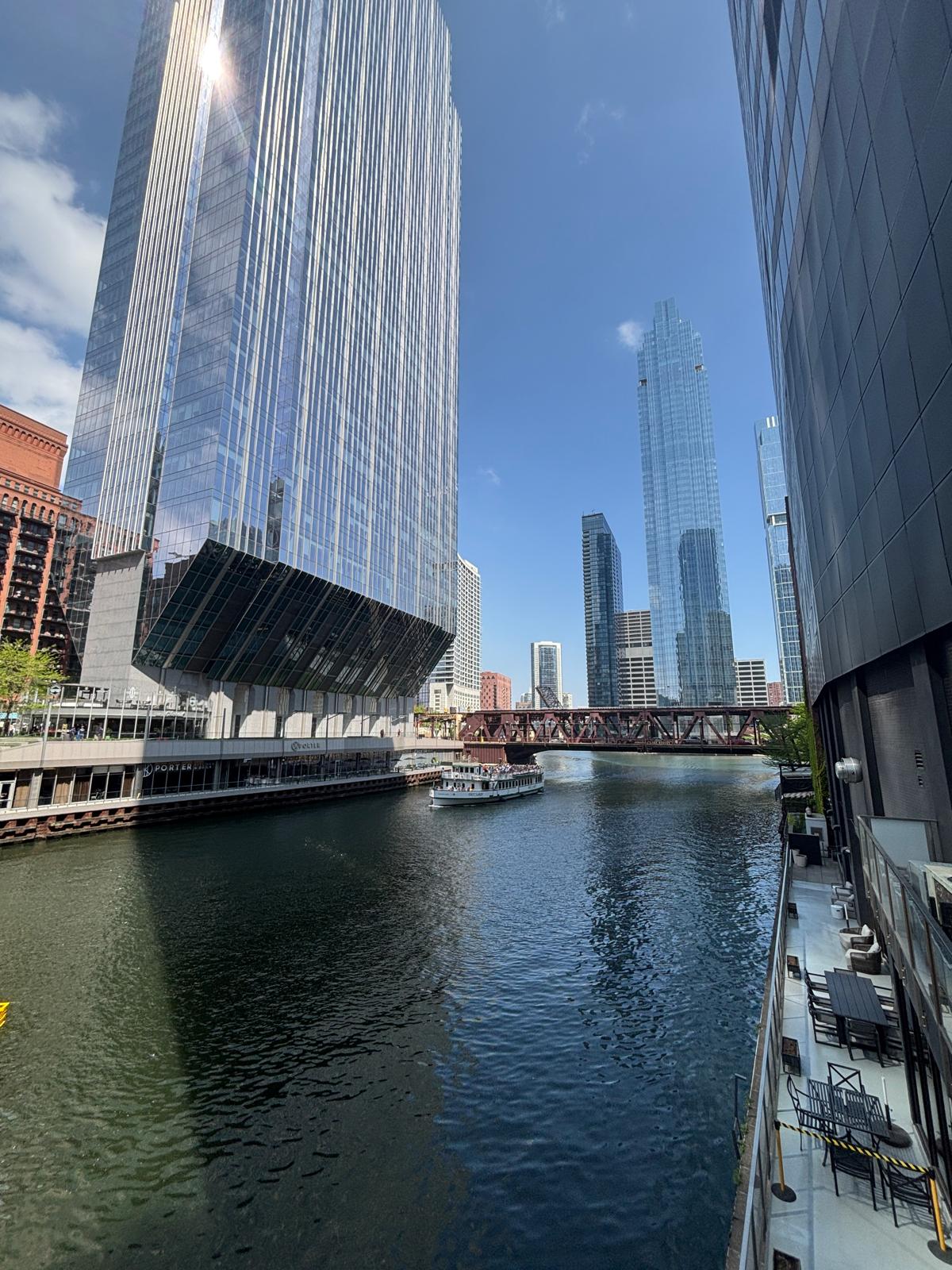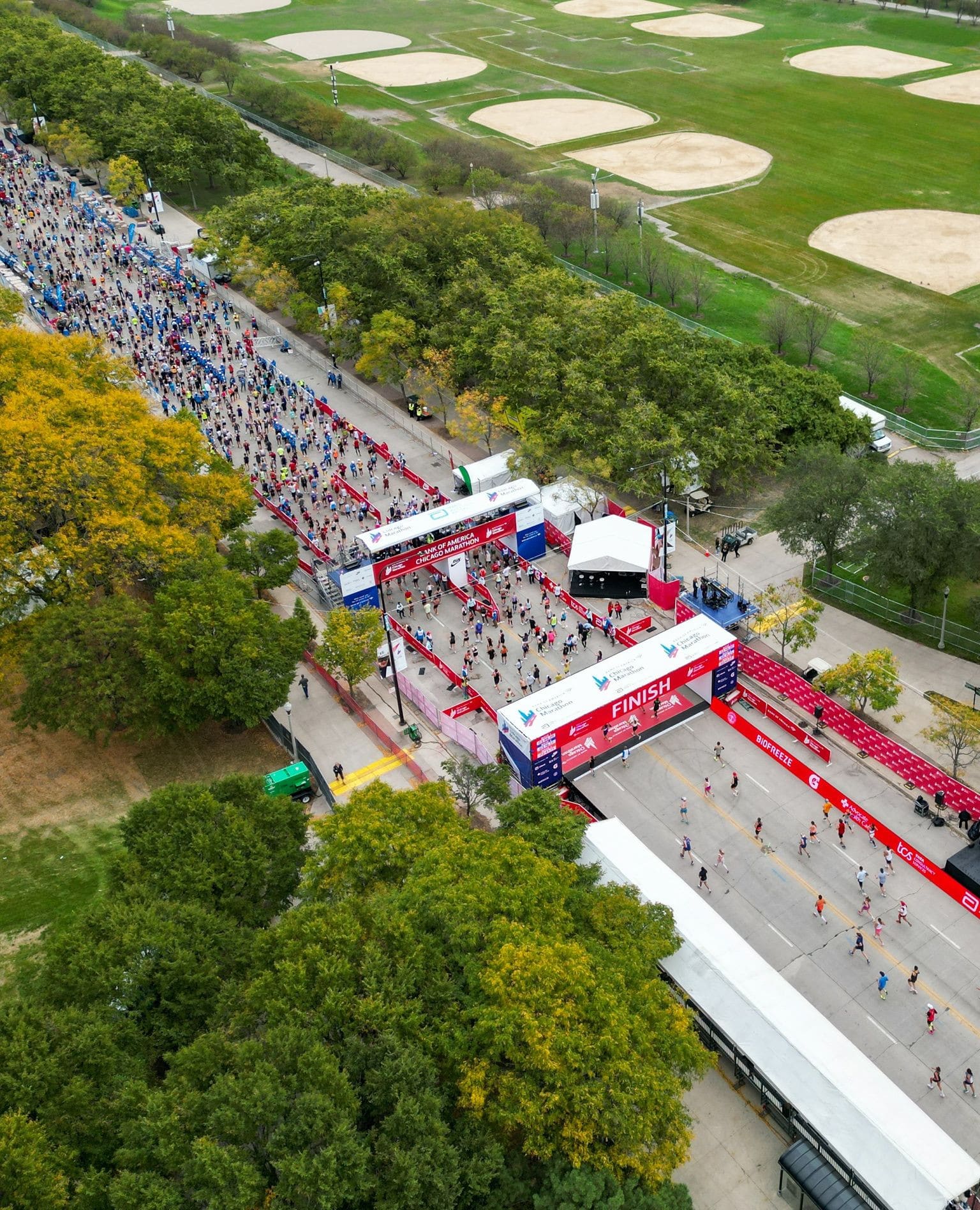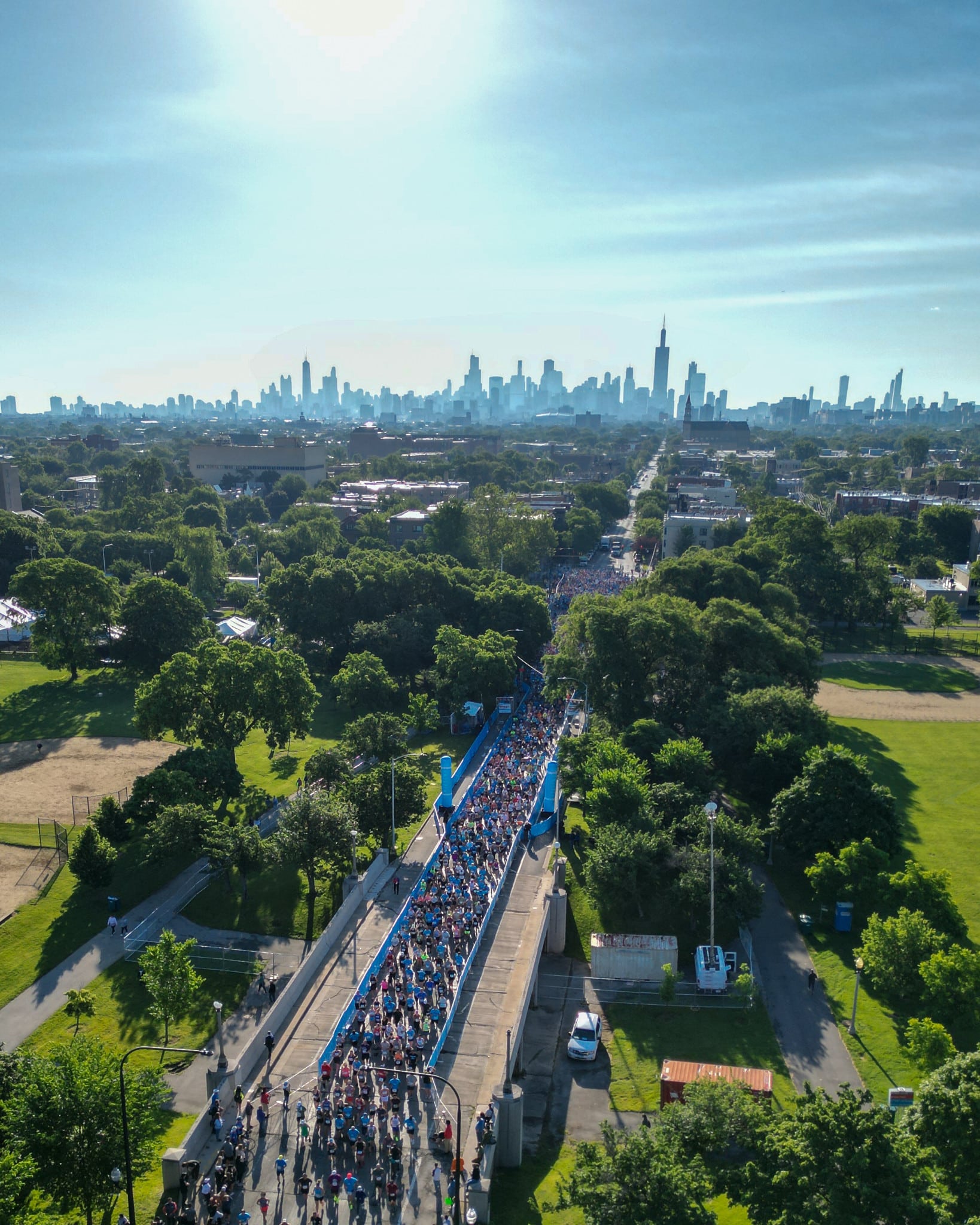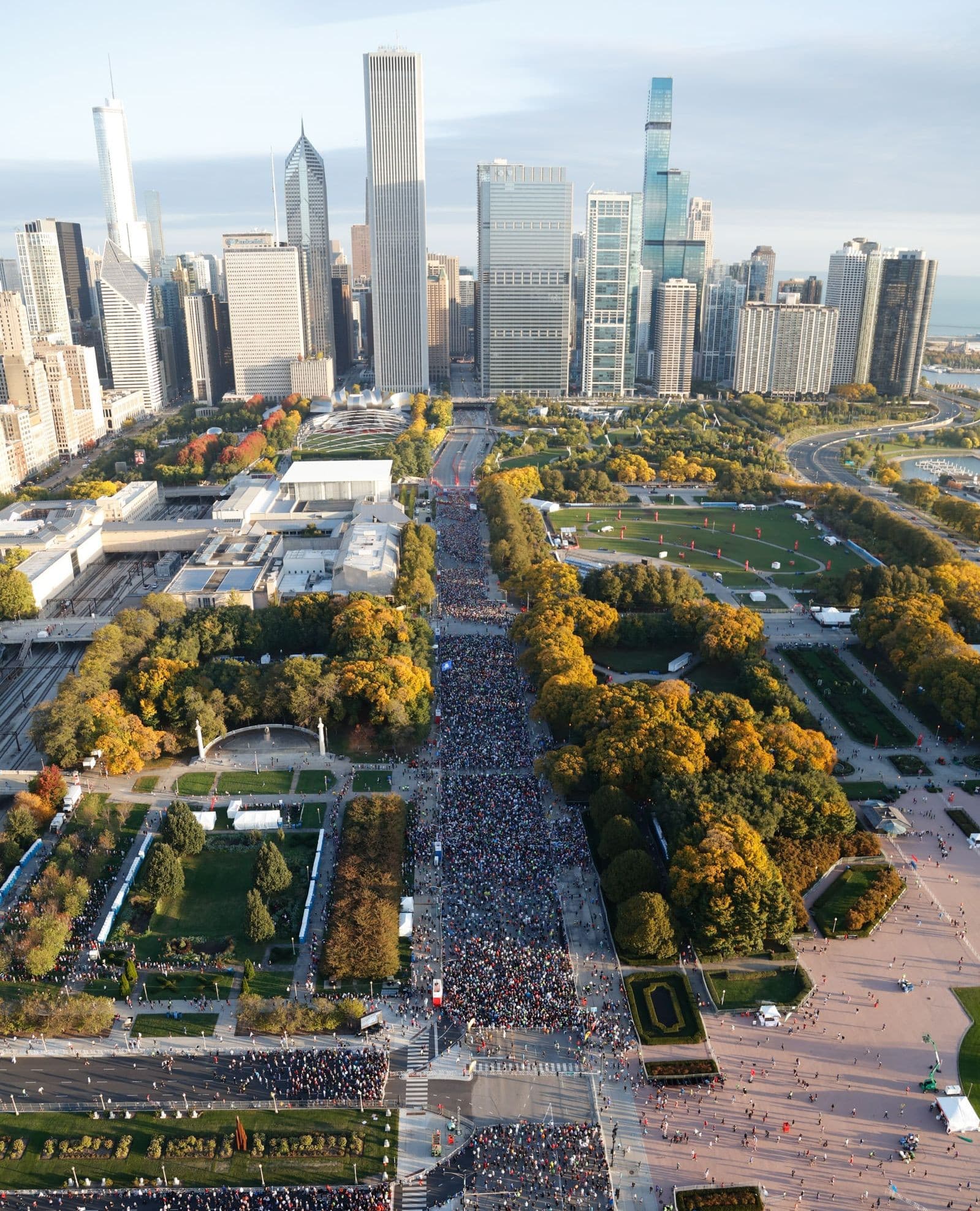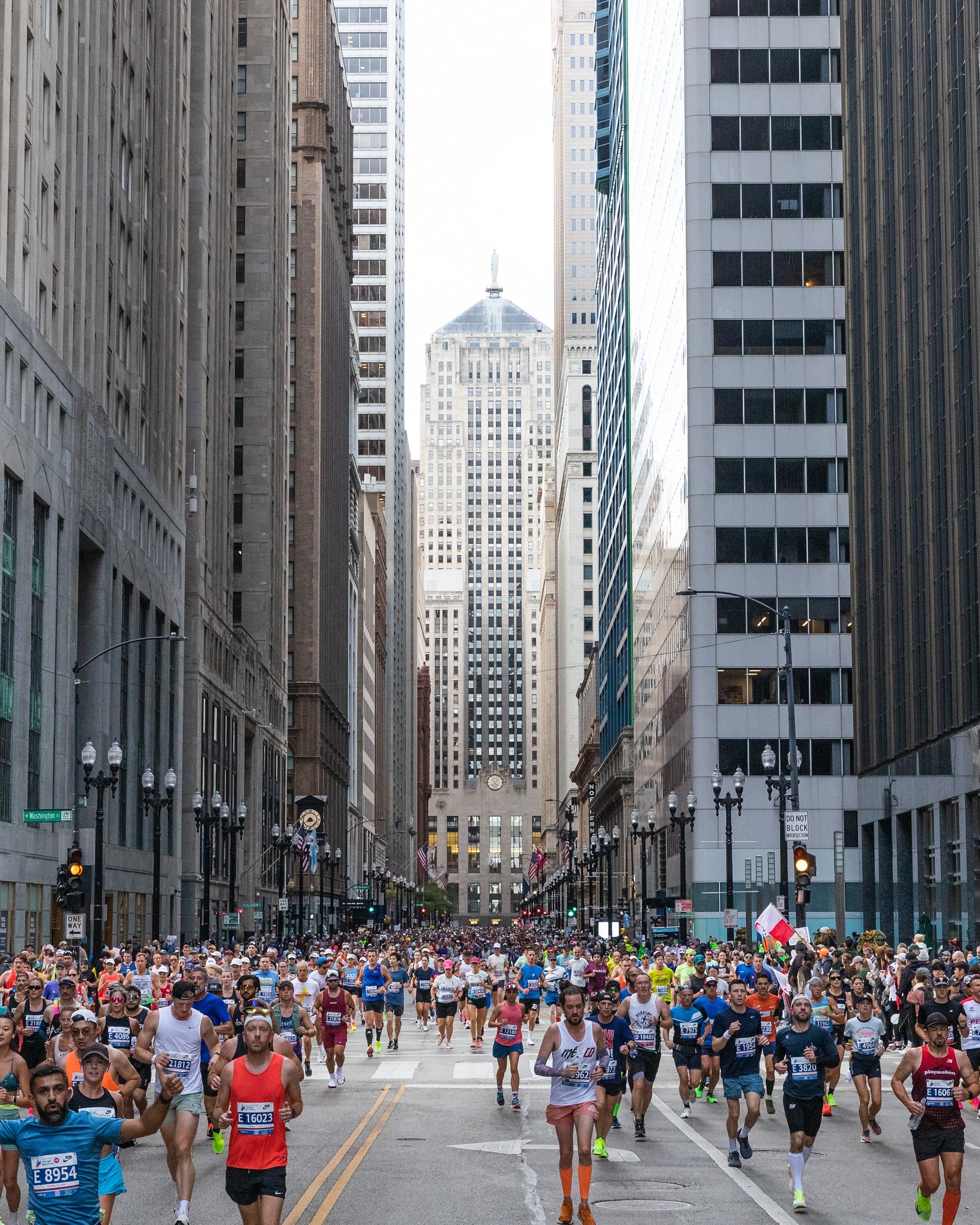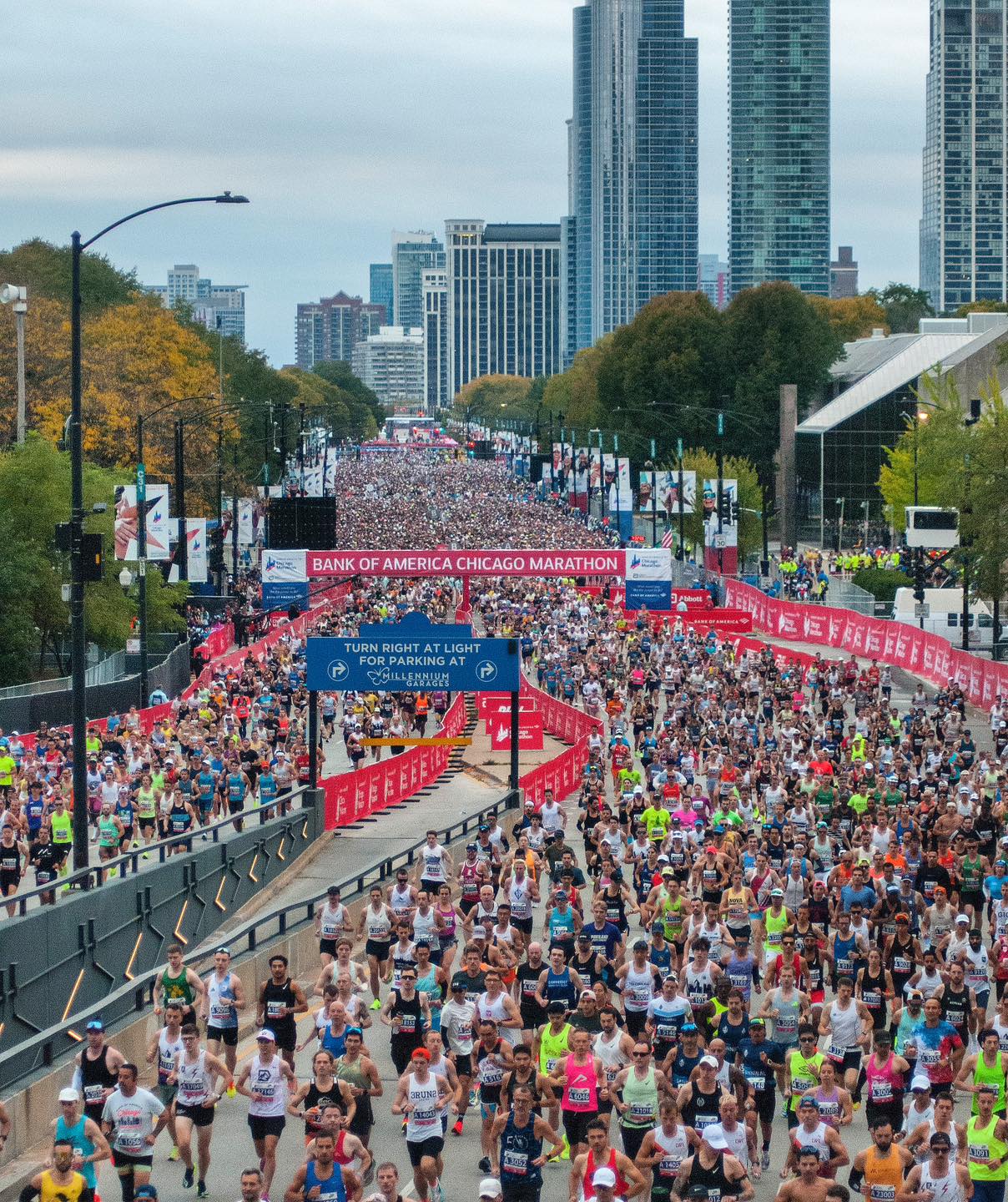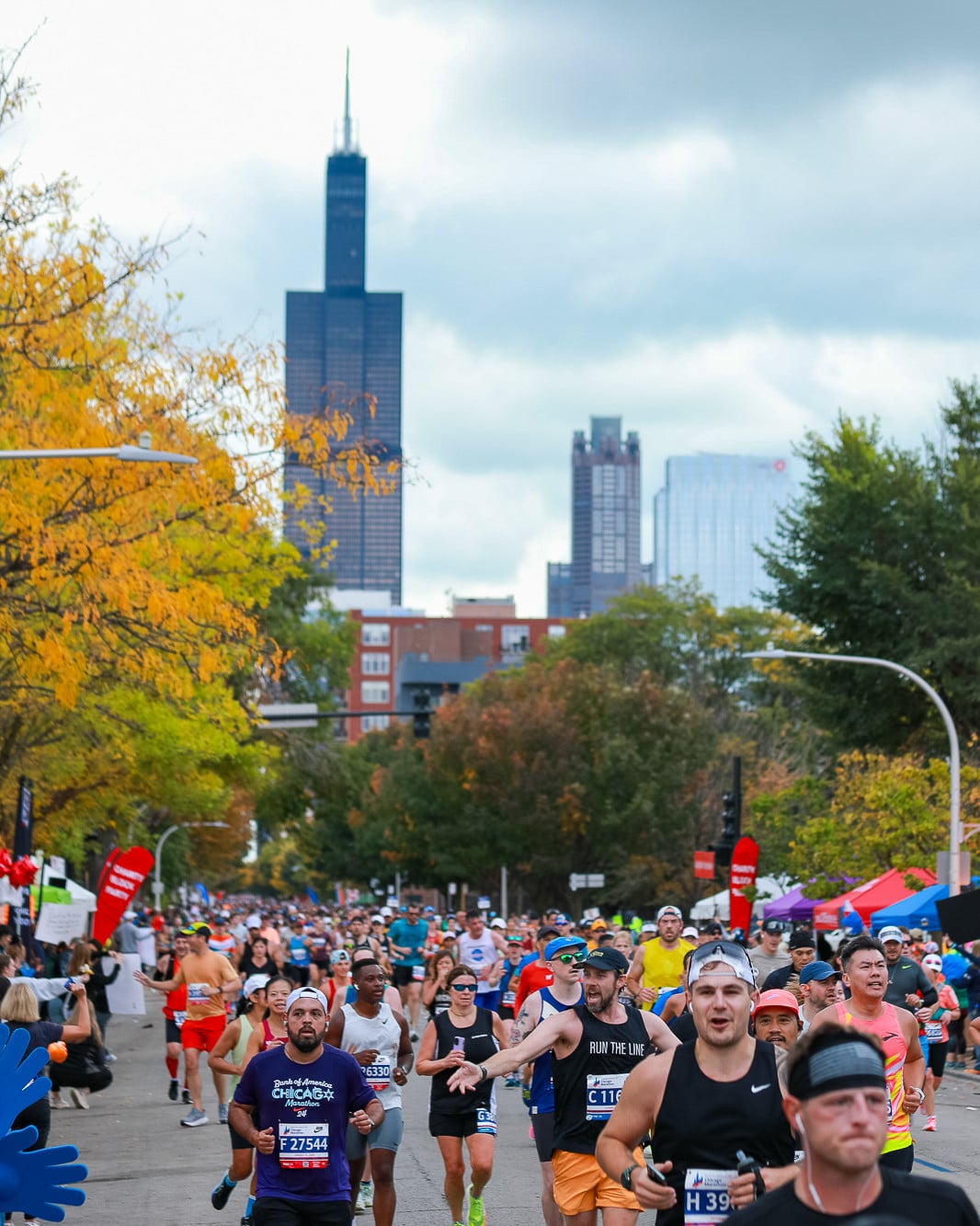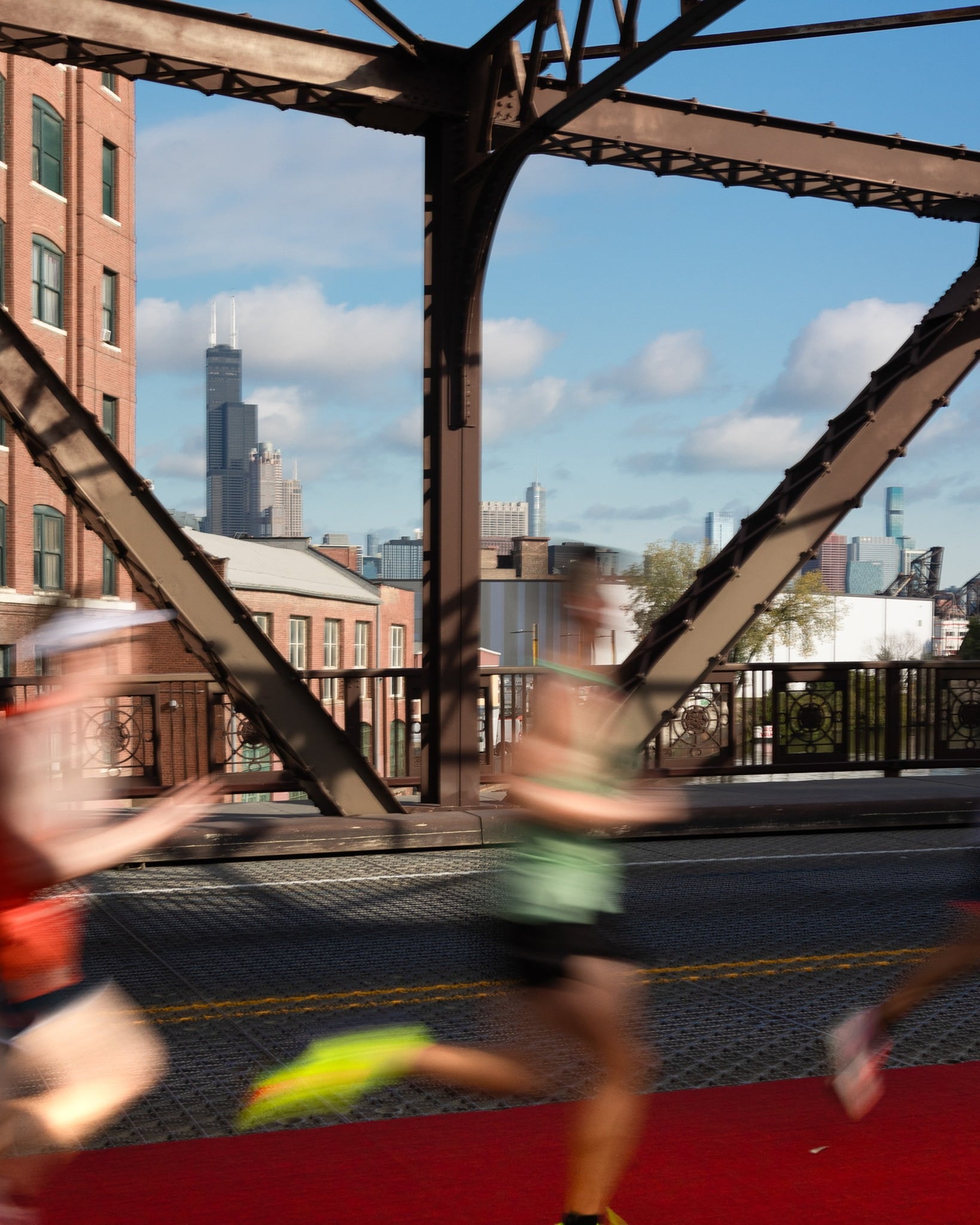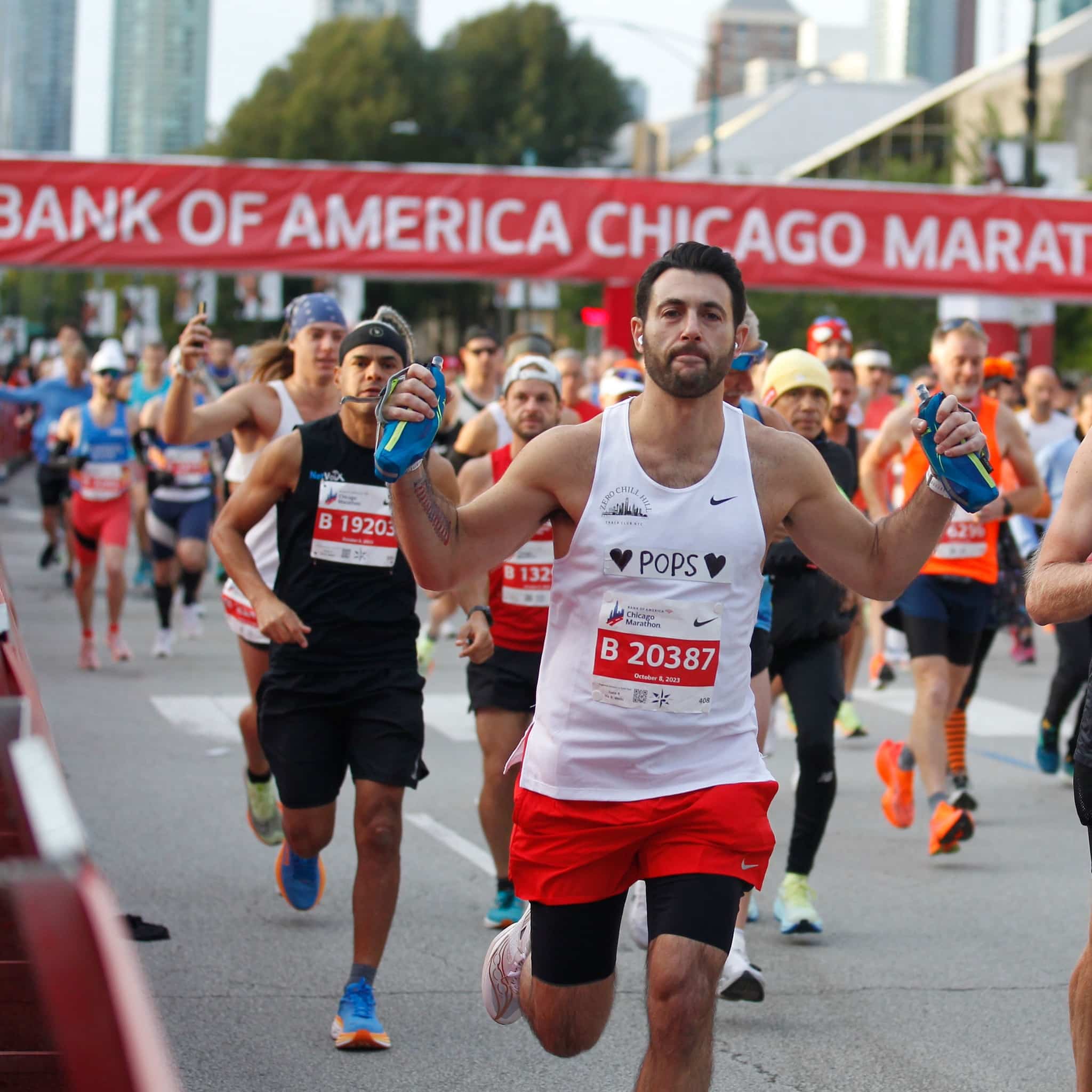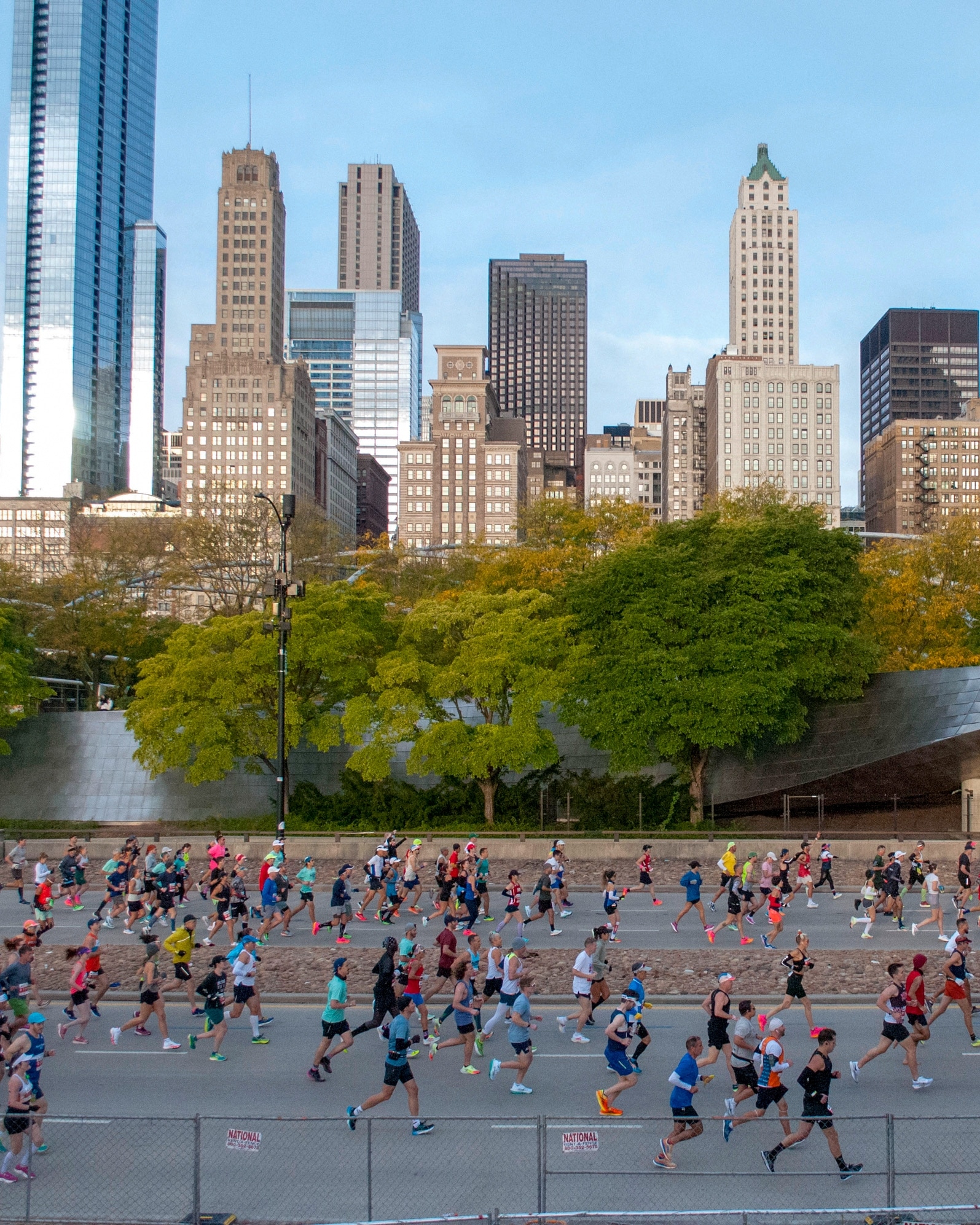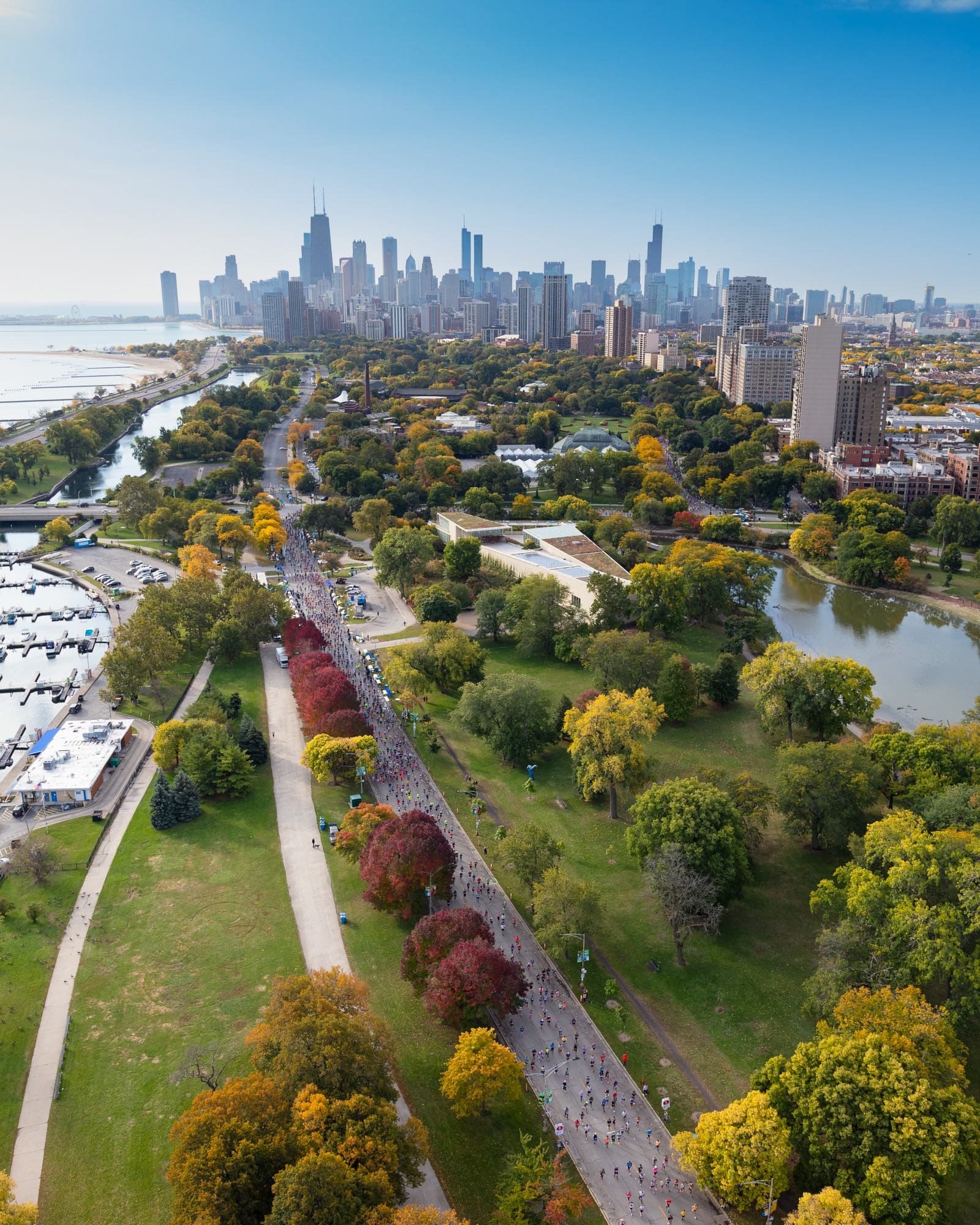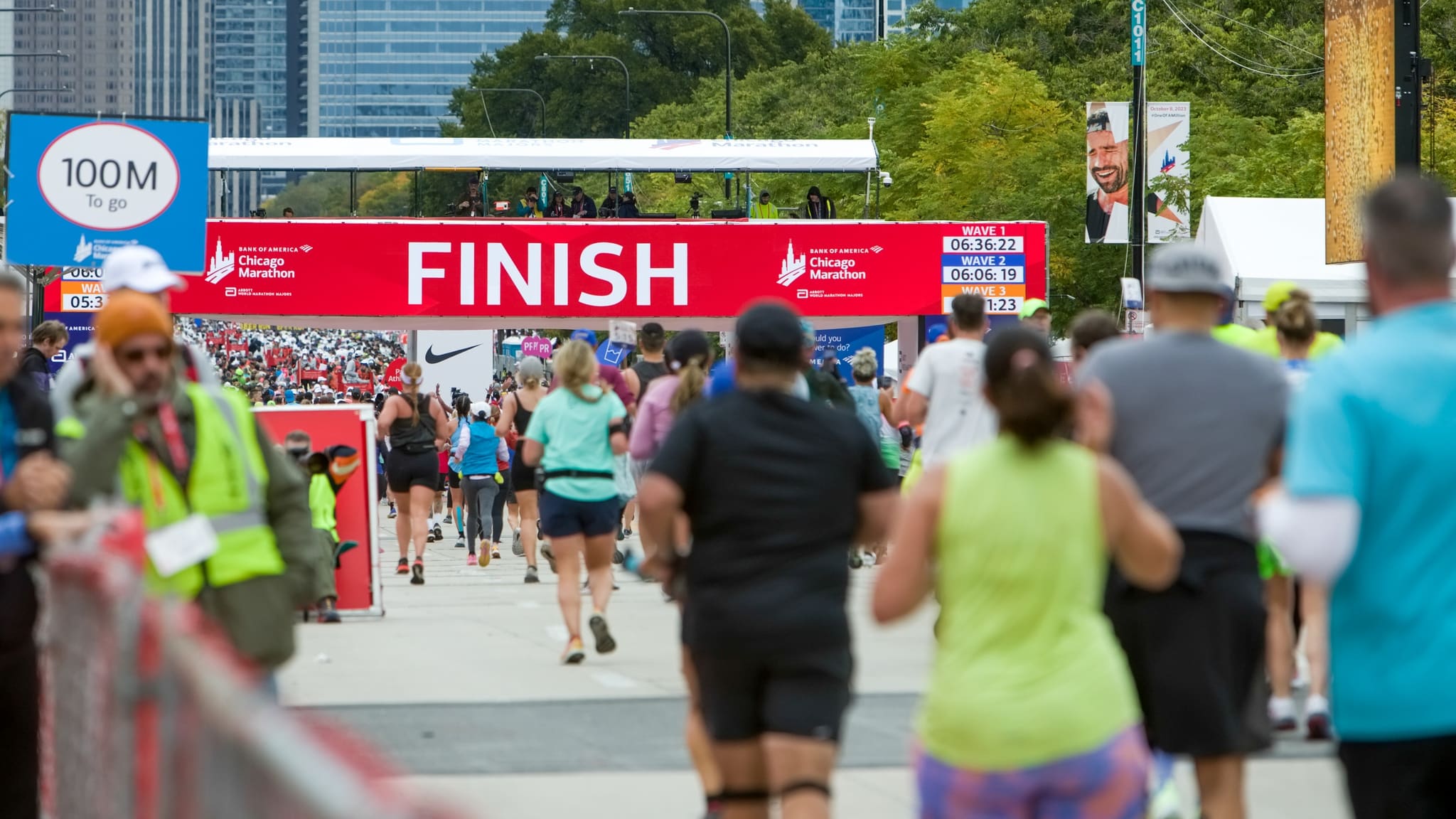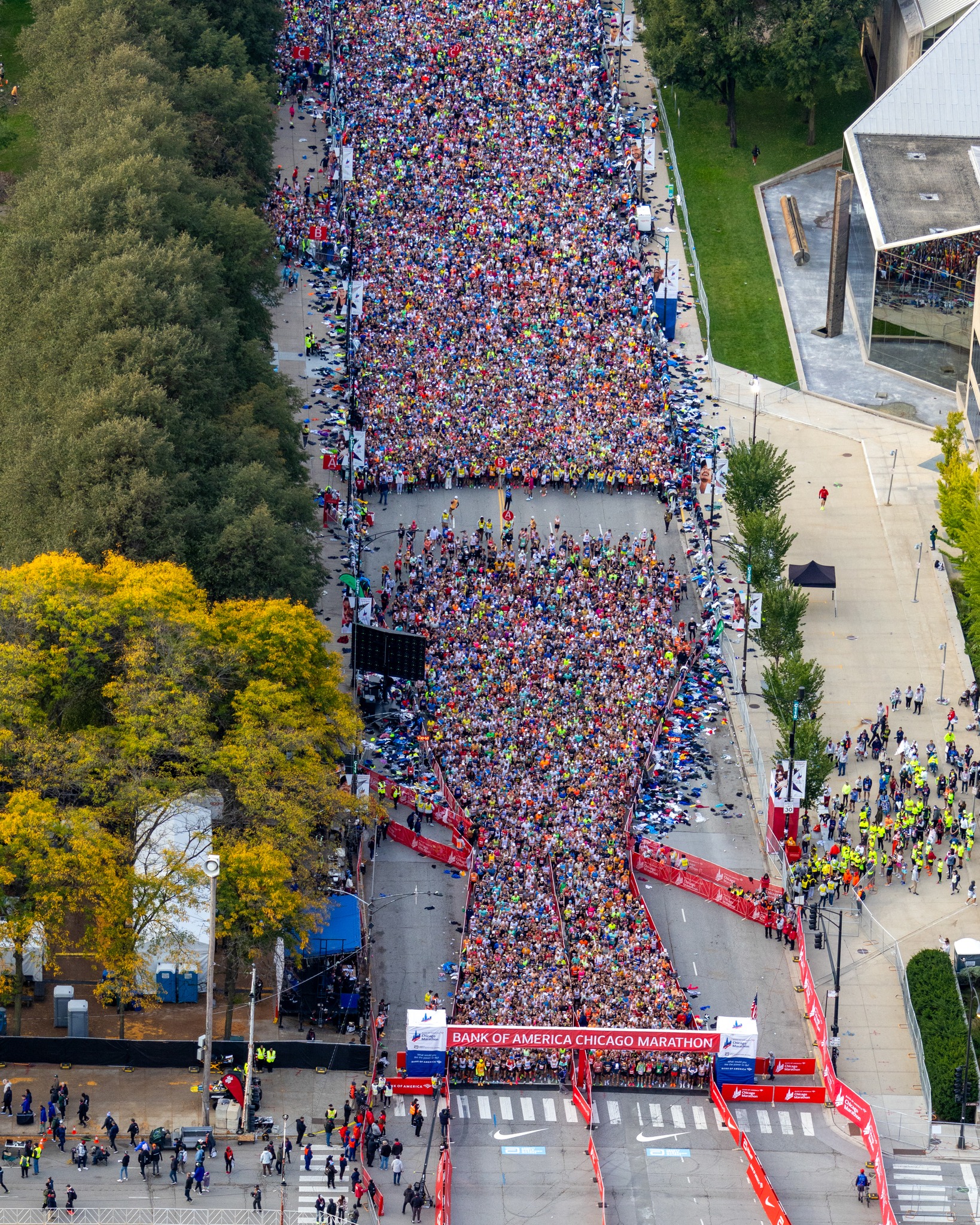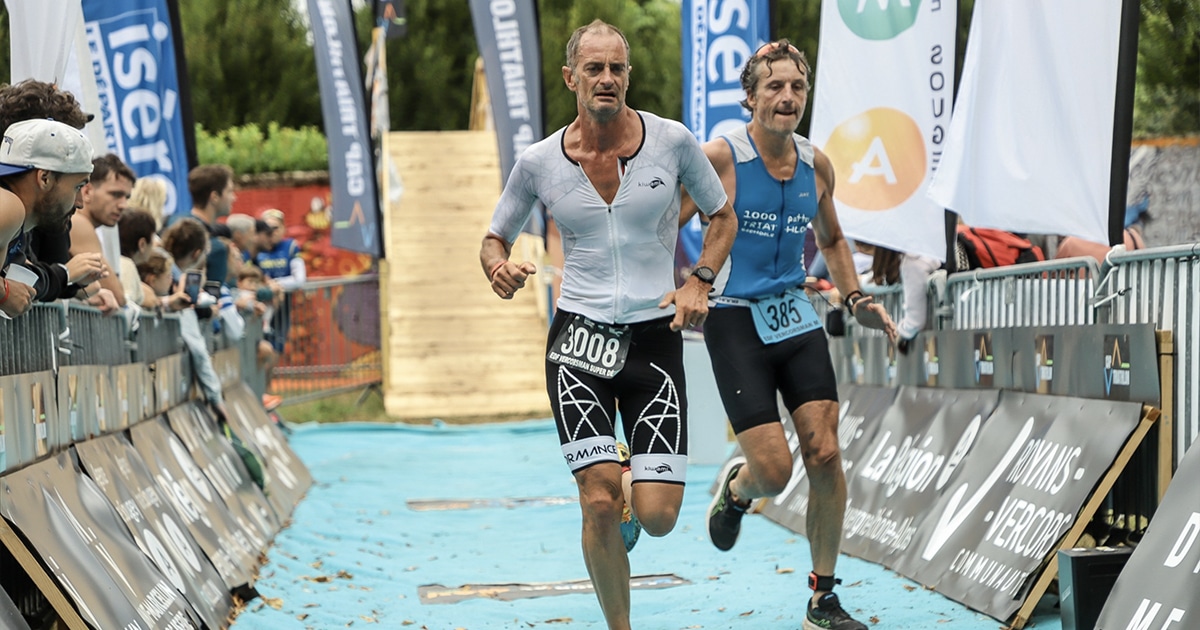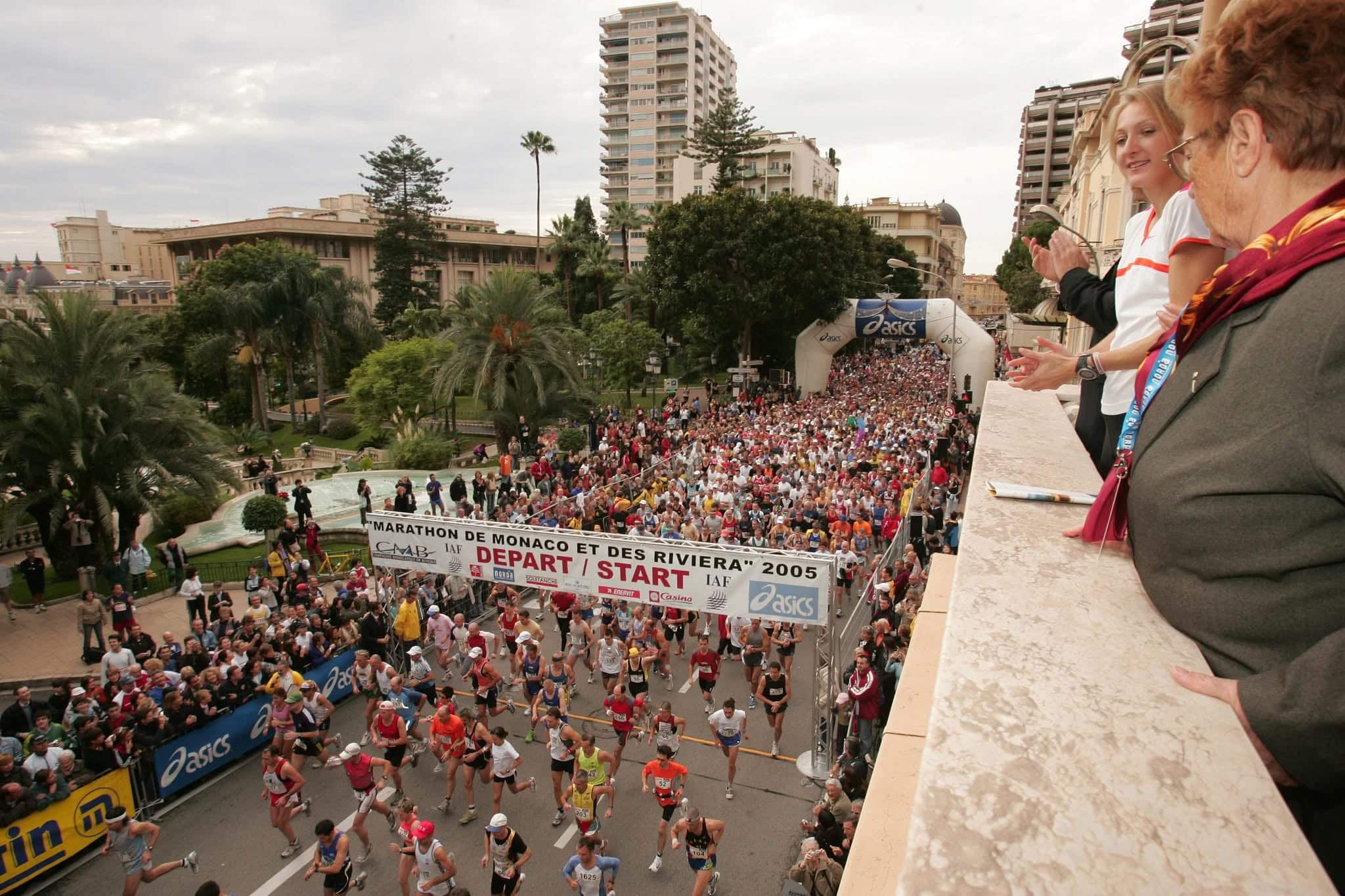Bank of America Chicago Marathon : Behind the scenes of a legendary race
The Bank of America Chicago Marathon, held in Illinois, has been part of the prestigious Abbott World Marathon Majors since 2006. For elite athletes as well as first-time runners, this legendary race often represents the fulfillment of a lifelong dream. Flat, fast, and packed with energy, the course winds through a stunning backdrop that includes the shores of Lake Michigan, the Chicago River, and Millennium Park. Runners weave past green spaces and towering skyscrapers, making it a unique blend of nature and architecture. Recognized with the World Athletics Platinum Label, Chicago is one of the largest mass-participation running events in the world, attracting over a million spectators along its famously flat course. The city has even hosted world records on multiple occasions for both men and women.
➜ In April, ahead of the 2025 edition this fall, as Chicago prepares to once again welcome runners—as it has every year since September 23, 1905—Marathons.com sat down with Carey Pinkowski, Executive Race Director, Bank of America Chicago Marathon and Michael Nishi, General Manager, Bank of America Chicago Marathon, for an exclusive conversation.
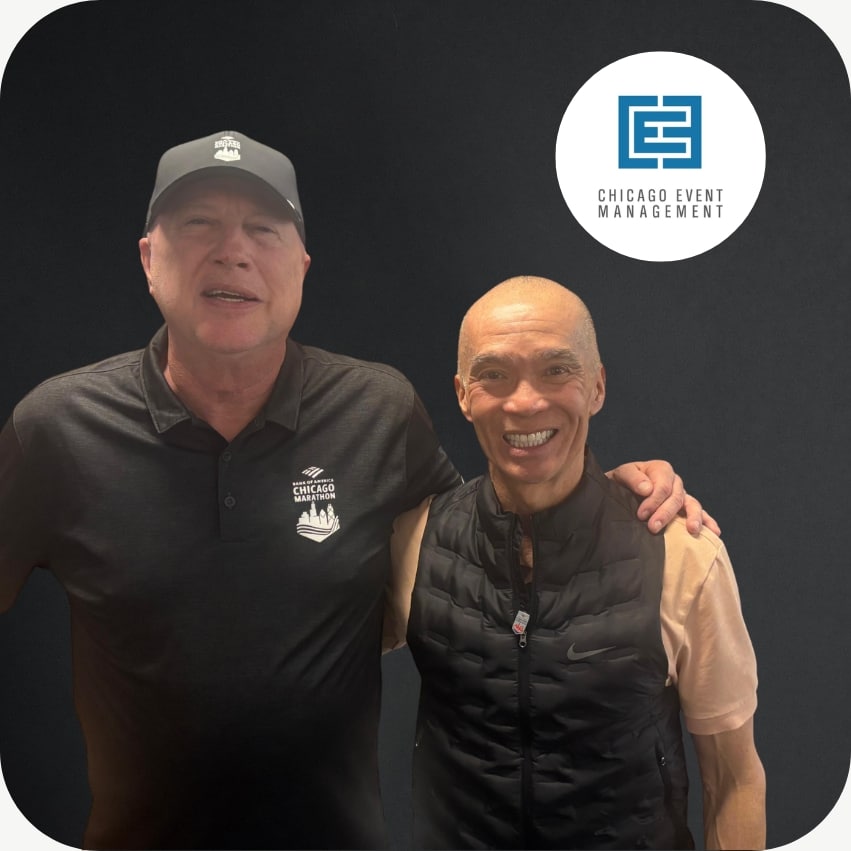
In this behind-the-scenes look at one of the sport’s most iconic races, we spoke with Carey Pinkowski (Executive Race Director, Bank of America Chicago Marathon) and Michael Nishi (General Manager, Bank of America Chicago Marathon) about the significance and challenges of organizing the Bank of America Chicago Marathon.
From 4,200 runners to more than 53,000: a marathon transformed
| The Bank of America Chicago Marathon has seen extraordinary growth since its revival in 1977, when just 4,200 runners paid a $5 entry fee. In 2025, more than 53,000 are registered for the 47th edition. How do you feel about this growth, and what do you think are the main drivers behind it?
Carey Pinkowski: First of all, I think people in the United States—and around the world—have rediscovered running as an activity in a world dominated by technology and speed, where everything moves at 500 miles an hour in all directions. Running creates communities. It’s the most accessible sport, offering both exercise and relaxation, and people embrace it in their own ways.
I’m convinced that once people discover running, they establish routines, take care of their mental health, and eventually begin to see the marathon as the ultimate expression of the sport. They focus on their pace and on the day they’ll step up to the starting line. Questions like “Do you run?” or “Have you ever run a marathon?” almost become part of someone’s identity—especially here in Chicago, and across the U.S.
We’ve also seen the massive arrival of women, who now make up half of our starting corrals. When Michael and I started, the number was much smaller—around 4% or 5% in our first marathon. One of the groundbreaking decisions we made was to offer equal prize money for women. At the time, it was controversial. Since men far outnumbered women, equal prize money sparked a lot of debate. It may be forgotten today, but it was a decisive step that fueled our growth.
A global collective: the Abbott World Marathon Majors
| Since 2006, Chicago has been part of the Abbott World Marathon Majors, alongside Boston, New York, London, Berlin, Tokyo and now Sydney. What has this inclusion meant for you?
Carey Pinkowski: The Majors are built on collaboration. We share ideas, best practices, and challenges—whether they’re medical, logistical, or about community relations. Being part of this collective makes us stronger. It allows us to innovate together, improve the runner experience, and give athletes better access to world-class events.
All of the races have strong relationships with one another. The professionals are courteous and respectful. But ultimately, we all face challenges. We’re all growing—our races themselves, our partnerships with cities, the ways we operate, our processes. It’s constant learning and development.
When the running boom hit, we began spending more time together—talking, meeting formally, and sharing our best lessons. That’s when we realized: we all face the same challenges, we share the same mindset, objectives, and vision. It’s better if we work together. And it’s not just race directors—it’s also our medical directors, our operations teams, our cities, our agencies, the way we collaborate across the board.
Our goal is to enhance the runner experience. That benefits the entire running industry. So we evolve collectively, as one group. The five founding members were there, then Tokyo joined, and more recently Sydney. It’s an excellent collaborative environment to test ideas, see what works, and give participants the best possible access. I believe it’s a major step forward for the sport.
Chicago’s remarkably high finisher rate
| Chicago has one of the lowest dropout rates in the world, with more than 99 percent of starters finishing. How do you achieve this?
Carey Pinkowski: I really like the word “collective,” because everything stems from collective momentum. There are so many training groups now, not to mention advances in shoes, apparel, nutrition, hydration, and the encouragement runners receive. They’re smarter, better prepared, more aware of their pace.
In the past, training was more solitary, and reliable information about running was harder to find. Now there are resources everywhere—websites, training groups, coaching guides—not just about the physical side but also about mental preparation.
So the whole experience has improved. Over the years, we’ve also made changes to help participants adapt to weather conditions, stay better informed about hydration, and so on. Our program has evolved over time, and that’s what helps so many finish.
Michael Nishi : Runners today are more informed. One of the big challenges for the marathon industry is that the sport is aging. Our focus is on attracting younger runners. We’re starting to see that demographic shift, and it’s happening across communities and the industry.
There’s an energy, a buzz from clubs and running crews. Recruitment now happens on social media, which appeals to younger runners and ties into health and fitness. That’s been a huge factor in the marathon’s success.
At races everywhere, fewer people are dropping out, and social media plays a role. It makes people want to show up, run, and share the experience. These new groups, as Carey said, are about community: training together, sharing information, building connections. Marathons have become platforms for engagement and social connection.
Carey Pinkowski: It’s a social phenomenon. Before, the common activity was meeting for a beer—now it’s meeting for a run. Physical activity has been rediscovered, and people support each other through it. They exchange advice, learn how to improve, and share the journey.
The social side matters too—what happens after training or after the race, like going out to eat together. Our 13.1 event showcases neighborhoods and city halls, and we involve residents in the planning. They tell us what they’d like to see, what music they’d enjoy, how they imagine the event. We listen, to make the race better and more accessible.
People who never thought about running start by walking, then jogging, then maybe a 5K, then a half. Eventually, they might consider a marathon. The goal is to get people moving. Movement builds confidence—it makes people stronger and more self-assured.
Michael Nishi : This event is authentic. It started in a community with limited resources, where nothing like it had ever existed. Creating something there has been remarkable. We’re lucky to see how it has changed lives. Running really does change lives.
We see participants at the starting line who never imagined they’d be there, people who used to be on the margins. In Garfield Park, for example, the life expectancy in West Garfield is 67 years. Just four miles away, it’s 85. If people get active, the community becomes stronger, and so does society as a whole.
The marathon’s impact on the city
| The race passes through 29 neighborhoods, highlighting Chicago’s cultural and architectural diversity. What’s the economic and social impact of the marathon on the city?
Carey Pinkowski: The course embodies Chicago’s character—local, diverse, and collaborative. Our team works closely with residents, volunteers, and businesses. Feedback from all these groups shapes the event. It’s a massive group effort, an ecosystem that brings everyone together.
We rely on residents for access to roads, on the police and the Park District for support, on the city’s incredible infrastructure. Runners are welcomed into neighborhoods, and volunteers make them feel part of the community. For the city, it’s a moment to shine.
Many participants are visiting Chicago for the first time, and for them, the marathon is an experience of discovery. Every year, we learn something new—about the city, its history, its people. Our marathon highlights that heritage. For instance, part of our half marathon course passes the spot where Abraham Lincoln was nominated to represent his party in the presidential race. Chicago’s history is everywhere along the course.
Safety and organization: a collective effort
| Organizing such a massive event is a logistical feat, especially since the Boston Marathon bombing in 2013. What are your biggest challenges in terms of safety and organization?
Carey Pinkowski: There are several factors to consider—weather, environment, and of course, safety. Our team does an incredible job anticipating challenges. In my opinion, Chicago is the best city event in the world because we’re fully integrated into the community and have tremendous support. We built this from scratch. The teams are fully engaged, and every person is invested.
We emphasize communication—talking to people, answering questions. I don’t think runners realize the full scale of the organization. It’s huge, and it takes time. Chicago is a collective effort involving all city agencies, especially the Chicago Police Department. It’s a true partnership built on trust, and transparency is why we receive permits. Everyone feels included in the plan, and that brings pride.
Everyone knows someone who runs Chicago—a cousin, a niece, a friend. It could even be a police officer or neighbor. The marathon is part of the city itself; that connection is what makes it thrive.
Michael Nishi : Thirty years ago, security was a concern, but not at the level it is today, especially after 2001. Suddenly, security became the top priority, and it grows stronger every year. Then came the Boston Marathon bombing. Safety will always be the top priority. We must constantly improve emergency measures because you never know what could happen.
Weather is another challenge—you can’t control it, and extreme heat can occur. In 2007, we should have stopped the race due to the heat. That remains one of the toughest issues, alongside legal and insurance matters. We learned a lot from that race, but we must keep improving in how we manage both people and logistics.
| You mentioned the 2007 heatwave. Do you still think about that event more than 10 years later?
Michael Nishi : Absolutely. It became the foundation of how we build our organizational plans. The program evolves every year, but we always look back. We don’t want to forget. Every experience helps us improve.
Fortunately, we have experienced people and strong support that allow us to handle these challenges today. We always prepare for the worst—those lessons shape us and help us progress.
Carey Pinkowski: That day woke everyone up—event organizers in Chicago and beyond. It led to the creation of a unified approach to race management. It was the first major event canceled mid-race, though I’m sure it happened at smaller events before.
We still had 26,000 finishers, but the heat forced us to reroute others away from the finish line. We still think about that day. We now rely on a unified structure—when decisions need to be made instantly, everyone supports the plan. Other major events, from Lollapalooza to NASCAR, also learned from it.
The following year, when similar heat struck again, we were prepared and able to respond.
Michael Nishi : We changed everything. We even introduced an Event Alert system because of that. It was unprecedented heat for autumn, and many thought it was a one-off—until it happened again the next year. We had to call in ambulances from outside the city. That year, half the medical cases were heat-related.
At first, Carey and I thought we were done—that we couldn’t support the city while caring for runners. But the following year, no city ambulances were needed. We relied on private ambulance services and managed it.
Carey Pinkowski: Many of our coordinators, vendors, and community members supported us. It showed the resilience of the city and our team. Other races now look to us as a model.
Michael has been instrumental in building this culture. We even invite other organizers to our race management program—a conference where they can observe operations and bring lessons back to their cities. Sharing best practices helps everyone.
A world-class course for elite performances
| The Bank of America Chicago Marathon course is known as one of the fastest in the world. How do you ensure it remains optimal year after year, both for record-breaking performances and for the overall smooth flow of the race?
Carey Pinkowski: The course isn’t completely flat—there are small inclines—but it’s long been a tradition for athletes to come here to chase fast times. More recently, Kelvin Kiptum and Ruth Chepngetich delivered historic performances.
Everyone views Chicago as one of the fastest marathons—like Berlin, the gold standard, with Valencia now rising. The two fastest marathon times in history were recorded in Chicago, confirming that it’s among the very fastest courses in the world.
With elite athletes, we maintain a genuine philosophy of competition. They’re also a major marketing asset. In Chicago, they’re welcomed warmly, given space to relax, train, and prepare. Our team makes sure they’re in the best possible condition.
We host a press conference and a few pre-race interviews, but we give them two full days to recharge. The start and finish are located right by their hotels, with shuttle buses for convenience and safety. That removes stress and sets them up for success.
Our elite team works closely with coaches and managers to ensure athletes feel at home. It’s a tradition that keeps them coming back—legends like Steve Jones, Rosa Mota, and Khalid Khannouchi.
When Kelvin Kiptum broke the world record here in 2023 at just 23, it was a turning point. He asked me about Khalid, who was in the stands. I told him Khalid symbolized peace. Kelvin thanked him for everything he had done for the sport. Khalid himself had once said that if anyone broke the record in Chicago, he hoped it would be Kelvin. That sense of tradition and responsibility is part of what makes Chicago special.
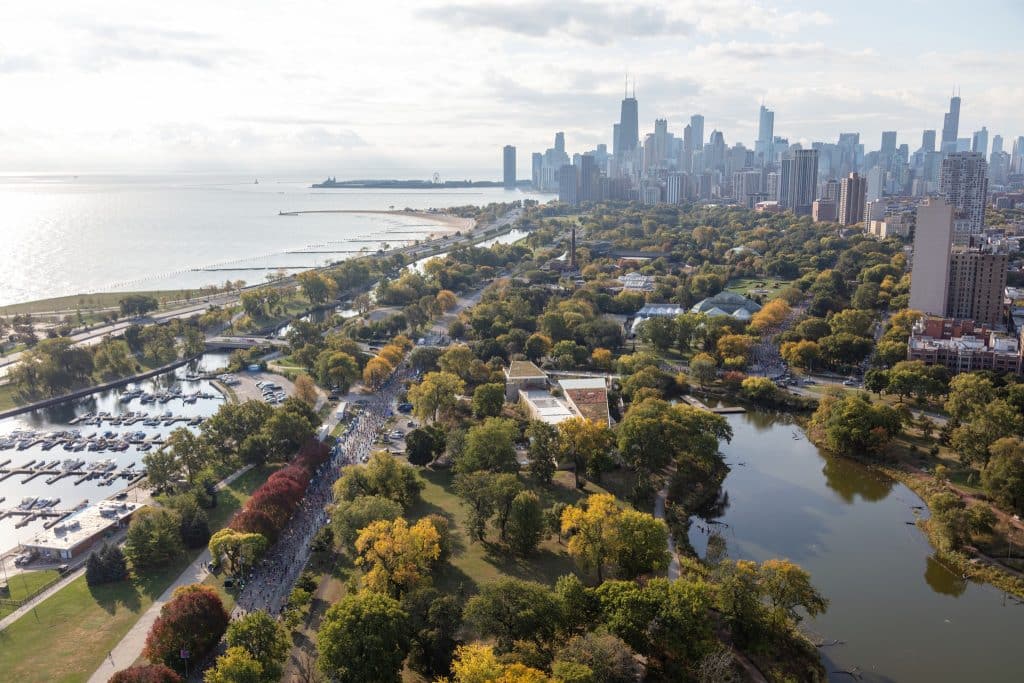
World records and the sub-two barrier
| Both marathon world records have been set in Chicago: Kelvin Kiptum (2:00:35 in 2023) for the men’s race, and Ruth Chepngetich (2:09:57 in 2024) for the women’s race (editor’s note : the interview was conducted before his provisional suspension following a positive test for a diuretic in July). Do these performances change Chicago’s reputation? Can we hope to see someone break the legendary two-hour barrier here?
Carey Pinkowski: Absolutely—it’s only a matter of time. I believe Kelvin Kiptum could have done it in Chicago. As the saying goes, he still had his foot on the brake when he set the world record—he was experimenting.
You could see it in how he ran the second half in 59:40, while being conservative in the first. He missed the two-hour mark by just 35 seconds. I had no doubt he would have achieved it in his next race, under the right conditions. Sadly, with his passing, we’ll never know.
Inclusivity and the future of the marathon
| Diversity and inclusivity seem central to the DNA of the Bank of America Chicago Marathon. How do you support this growing range of participants—women, veterans, athletes with disabilities? And how do you see the marathon evolving over the next decade?
Carey Pinkowski: Inclusivity and diversity are at the heart of our vision at CEM, in partnership with Bank of America and our sponsors. Our promotional images and banners reflect the real diversity of our participants. We want to reach all communities.
We’ve had strong support from Black running clubs, from the West Coast, the South, and beyond. Michael has been a steward of equity, ensuring clubs have access. We invite runners to join even if they can’t afford entry. We encourage communities to make the marathon their own.
Michael Nishi: Accessibility is key. We’ve designed medals for visually impaired runners and bibs for deaf participants that indicate potential hazards. These details help athletes feel safe and welcome. We also highlight neurodiverse participants so they can inspire others. Inclusivity is something we dedicate real time and attention to.
Carey Pinkowski: Janet from our staff even hired artists from diverse communities, including minority groups, to create our visuals. Chicago is a city of neighborhoods and cultures, proud of its diversity. It’s not a challenge—it’s who we are.
And it’s not just about world-record holders. It’s about runners finishing in three or four hours, from all walks of life. That’s the core of our message: everyone belongs.
Looking ahead
| In 2025, new challenges and expectations are emerging. What innovations are you introducing this year? And do you already have long-term goals?
Michael Nishi: We just held a meeting for our 50th anniversary in 2028. If you’re only planning for next year, you’re already behind.
Carey Pinkowski : What’s amazing is that during the meeting, no one looked at their phones. People were fully engaged, connecting face to face. That’s what running does—it brings people together. You can run 20 miles alongside someone you’ve never met, from Germany or South America, and suddenly you’re helping each other.
Running is simple, like how kids interact in a playground. It’s a way of discovering the world around you, and it’s fun. We all live busy, stressful lives. Running takes time, but it gives so much back. It builds team spirit, memories, and relationships. We know a runner named Randy who has run 47 marathons and plans to hit 50 by 2028. He’s 70 years old. For many, though, Chicago is their very first marathon. Our job is to keep them engaged, to make them want to come back.
Thirty years ago, when I first arrived at Grant Park, I told Michael that if we ever had 10,000 participants, we’d be set. Now, 55,000 show up, and we still manage to make it work.
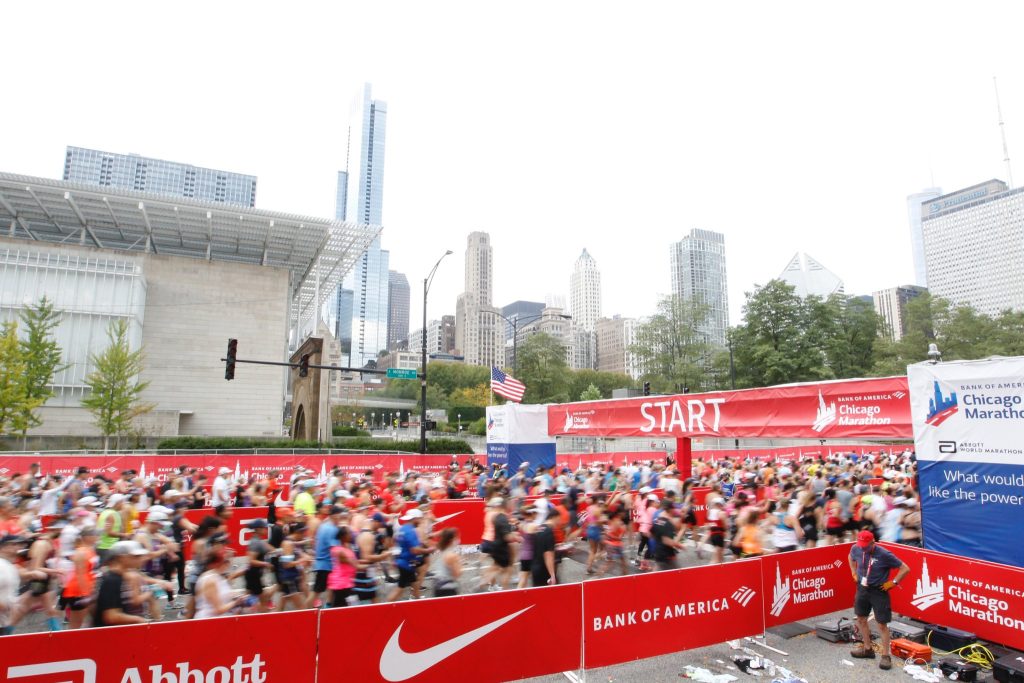
Beyond Chicago: favorite races
| Apart from your races, what are your favorite events?
Carey Pinkowski: I love Boston for its tradition. They do an incredible job honoring the history of the event. They pay tribute to the runners who have pushed themselves there, and they are truly in tune with that. It’s an aspect I really appreciate, especially since it’s the oldest marathon in the world. I remember watching the race as a child and being fascinated. It’s a challenging race—the Newton Hills are part of the spectacle. I really enjoy the city’s atmosphere, spending a weekend there, appreciating the energy, the history, and, of course, the tradition.
Michael Nishi: I’d also have to say Boston, because that’s where I ran my personal best. I don’t really remember the race itself—each marathon is unique—but the experience stayed with me. I also really enjoyed New York. Even though it rained, which made it tougher, it was still an incredible event. Getting to Staten Island was exhausting—it was cold, it was a tough day—but I loved it. I remember running through Central Park and those final moments approaching the finish line. I had cramps on the incline at 57th Street, that last uphill before the finish. I remember stopping because of the cramp, and the crowd pushing me forward to get across the line.
The Bank of America Chicago Marathon represents far more than just a race: it’s a true celebration of running, blending elite performances, a lively public atmosphere, and a spectacular setting. With a well-oiled organization, a passionate community of runners, and a vibrant city, this event remains a must for both elite athletes and amateurs alike. Kudos to Carey Pinkowski and Michael Nishi, whose passion and dedication keep the heart of this legendary marathon beating. As the 2025 edition approaches, Chicago continues to write its story—ever richer and more inspiring—paced by thousands of determined strides.
➜ The 2025 Chicago Marathon will take place on October 12. Check out all the details!
